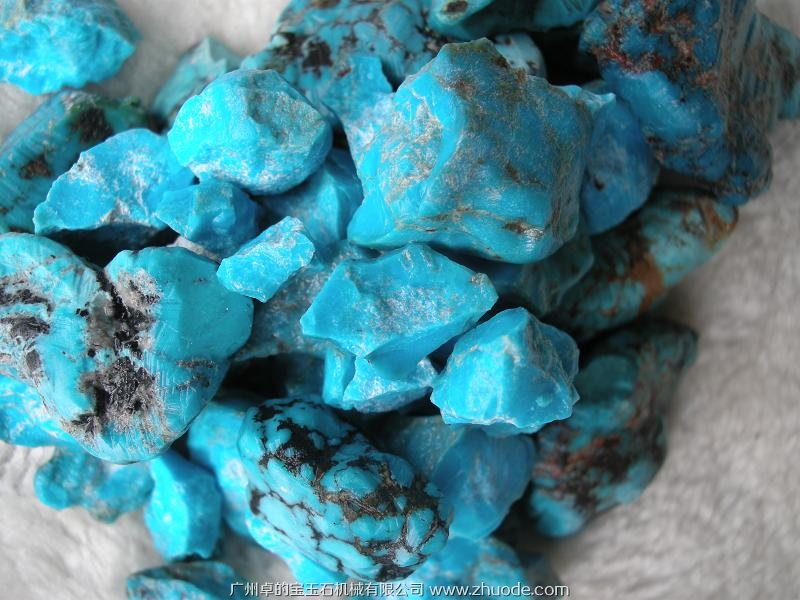
Turquoise is an opaque mineral that
occurs in beautiful hues of blue, blue-green and yellow-green. It has been
treasured as agemstone for thousands of years. Isolated from one another,
the ancient people of Africa, Asia, South America and North America
independently made turquoise one of their preferred materials for producing
gemstones, inlay and small sculptures.
Chemically, turquoise is a hydrous phosphate of copper and aluminum (CuAl6(PO4)4(OH)8·5H2).
Its only important use is in the manufacture of jewelry and ornamental objects.
However, in that use it is extremely popular - so popular that the English
language uses the word "turquoise" as the name of a blue-green color
that matches the stone. Very few minerals have a color that is so well known,
so characteristic and impressive that the name of the mineral becomes so
commonly used. Only three other minerals - gold, silver and copper have
a color that is used in common language more than turquoise.
Turquoise Colors
Blue minerals are rare and that is why turquoise captures attention in the
gemstone market. The most desirable color of turquoise is a sky blue or robin's
egg blue. Some people inappropriately describe the color as "Persian
blue" after the famous high quality material mined in the area that is now
known as Iraq. Using a geographic name with a gem material should only be done
when the material was mined in that locality.
After blue, blue-green stones are preferred, with yellowish green material
being less desirable. Departure from a nice blue color is caused by small
amounts of iron substituting for aluminum in the turquoise structure. The iron
imparts a green tint to the turquoise in proportion to its abundance.
Turquoise, especially the more porous varieties, can discolor with exposure to
prolonged sunlight, heat, cosmetics, perspiration and body oil.
Some turquoise contains inclusions of its host rock (known as matrix) that
appear as black or brown spider-webbing or patches within the material. Many
cutters try to produce stones that exclude the matrix but sometimes it is so
uniformly or finely distributed through the stone that it cannot be avoided.
Some people who purchase turquoise jewelry enjoy seeing the matrix within the
stone, but as a general rule, turquoise with heavy matrix is less desirable.
Some turquoise localities produce material with a characteristic color and
appearance. For example, the Sleeping Beauty Mine is known for its light blue
turquoise without matrix. Much of the turquoise from the Kingman Mine is bright
blue with a spider web of black matrix. The Morenci Mine produces a lot of dark
blue turquoise with pyrite in the matrix. Much of the Bisbee
turquoise has a bright blue color with a chocolate brown matrix. People who
know turquoise can often, but not always, correctly associate a stone with a
specific mine.
|
Physical Properties of Turquoise |
|
|
Chemical Classification |
phosphate |
|
Color |
sky blue (most desirable as a gemstone), blue, blue green, yellowish green, often with brown, black or metallic matrix spider-webbing through the material |
|
Streak |
white, greenish |
|
Luster |
waxy to subvitreous |
|
Diaphaneity |
nearly opaque |
|
Cleavage |
perfect |
|
Mohs Hardness |
5 to 6 |
|
Specific Gravity |
2.6 to 2.9 (variable because of porosity) |
|
Diagnostic Properties |
color |
|
Chemical Composition |
CuAl6(PO4)4(OH)8·4H2O |
|
Crystal System |
triclinic |
|
Uses |
decorative stone, gemstone |
Turquoise Occurrence
Turquoise is rarely found in well-formed crystals. Instead it is usually an
aggregate of microcrystals. When the microcrystals are packed closely together,
the turquoise has a lower porosity, greater durability, and polishes to a
higher luster. This luster falls short of being "vitreous" or
"glassy." Instead many people describe it as "waxy" or
"subvitreous." Porous turquoise is sometimes treated by soaking it in
melted wax or impregnating it with polymer plastic to improve its
characteristics.
Turquoise forms best in an arid climate, and that determines the geography of
turquoise sources. Most of the world's turquoise rough is currently produced in
the southwestern United States, China, Chile, Egypt, Iran, and Mexico.
In these areas, rainfall infiltrates downward through soil and rock, dissolving
small amounts of copper. When this water is later evaporated, the copper
combines with aluminum and phosphorus to deposit tiny amounts of turquoise on
the walls of subsurface fractures.
Turquoise can also replace the rock in contact with these waters. If the
replacement is complete, a solid mass of turquoise will be formed. When the
replacement is less complete, the host rock will appear as a "matrix"
within the turquoise. The matrix can form a "spider web,"
"patchy" design, or other pattern within the stone.
The Turquoise Group of Minerals
The turquoise group consists of five monoclinic minerals with a similar
chemical composition and structure. Included are: Turquoise, Aheylite, Chalcosiderite,
Faustite, and Planerite. Their compositions are listed below.
|
Mineral |
Chemical Composition |
|
Turquoise |
CuAl6(PO4)4(OH)8·4H2O |
|
Aheylite |
(Fe,Zn)Al6(PO4)4(OH)8·4H2O |
|
Chalcosiderite |
Cu(FeAl)6(PO4)4(OH)8·4H2O |
|
Faustite |
(Zn,Cu)Al6(PO4)4(OH)8·4H2O |
|
Planerite |
Al6(PO4)2(OH)8·4H2O |
Turquoise in the United States
Most of the turquoise production in the United States has been located in the
arid southwest, and most of that production has been in or around deposits of
copper. Arizona, New Mexico and Nevada have all held the position of
the leading turquoise-producing state. New Mexico held that position until the
1920s, Nevada held the position until the 1980s and Arizona is currenty the
leading state. Significant amounts of turquoise have been produced in California,
Colorado, Utah, Texas and Arkansas.
Most of the turquoise is a byproduct of copper production. The large open-pit
copper mines excavate down through the shallow rock units where the turquoise
is formed. When turquoise is encountered the quantity and quality of the
material is assessed and if warranted, a temporary effort is made to recover
the gem material. If the value of the turquoise is worth disrupting the mining
operation it will be mined. The mining could be done by copper company employees
but the job is often given to contract miners who are able to come in and
quickly recover the turquoise.
Turquoise Jewelry and Art
The earliest record of turquoise being used in jewelry or in ornaments is from
Egypt. There turquoise has been found in royal burials over 6000 years old.
About 4000 years ago, miners in Persia produced a blue variety of turquoise
with a "sky blue" or "robin's egg blue" color. This
material was very popular and traded through Asia and into Europe. This is the
source of the term "Persian Blue" color.
In North America the earliest known use of turquoise was in the Chaco Canyon
area of New Mexico, where the gem was used over 2000 years ago. Ancient artists
produced beads, pendants, inlay work, and small sculptures (see photos in the
right column).
Rough turquoise and turquoise objects were held in high regard by Native
Americans and were traded widely. This spread North American turquoise across
the southwest and into South America. These early Native American jewelry designs
were simple, and the turquoise was not set in metal findings.
In the late 1800s, Native American artists began using coin silver to make
jewelry. This work evolved into the turquoise and sterling silver style of
Native American jewelry that is popular today.
The demand for turquoise and turquoise jewelry rises and falls over time. In
the United States there was a surge in demand that began in the 1970s and
declined in the 1980s. Demand for turquoise jewelry is always highest in the
southwestern states where turquoise mining and Native American artists make
turquoise part of the local culture.
Synthetic and Imitation Turquoise
A small amount of synthetic turquoise was produced by the Gilson Company in the
1980s, and some of their material was used to make jewelry. It was produced in
a sky blue color, sometimes with a gray spider webbing. It was a ceramic
product with a composition similar to natural turquoise.
Synthetic turquoise, and turquoise simulants have been produced in Russia and
China since the 1970s. They are prolific producers. The material is used to
make cabochons, beads, small sculptures and many other items. A photo in the
right column of this page shows some synthetic turquoise cabochons made in
Russia.
There are many different glass, plastic and ceramic materials with an
appearance similar to turquoise. Many of these can easily be distinguished from
turquoise by testing their hardness, specific gravity or other properties.
Look-Alike Materials
Howlite and magnesite are light gray to white minerals that often have markings
that resemble the spider webbing seen in some turquoise. They can be dyed a
turquoise blue color that makes them look very similar to natural turquoise.
These dyed stones fooled many people when they first entered the marketplace
and still are mistaken for genuine turquoise by unfamiliar buyers.
Dyed stones have damaged the market for genuine turquoise. They have been
purchased with the thought that they were turquoise by many people and have
produced uncertainty in the mind of many jewelry buyers. This causes some
people to avoid turquoise jewelry.
Today dyed howlite and magnesite are still used to make mass-produced
beads, cabochons, tumbled stones and other turquoise look-alike items. They are
almost ubiquitous in the marketplace. The dye generally does not penetrate
deeply into the material. Scratching the back of a stone with a pin will often
reveal a white interior. When heavily dyed, a stone must be scratched deeply or
be broken to reveal the light interior.
A few minerals are sometimes confused with turquoise by people who are
unfamiliar with turquoise. These minerals include: variscite, larimar,
blue-green chalcedony, lapis lazuli and chrysocolla. Simple tests will usually
differentiate these materials; however, some of the tests are destructive and
are usually not suitable for use on finished jewelry items.




